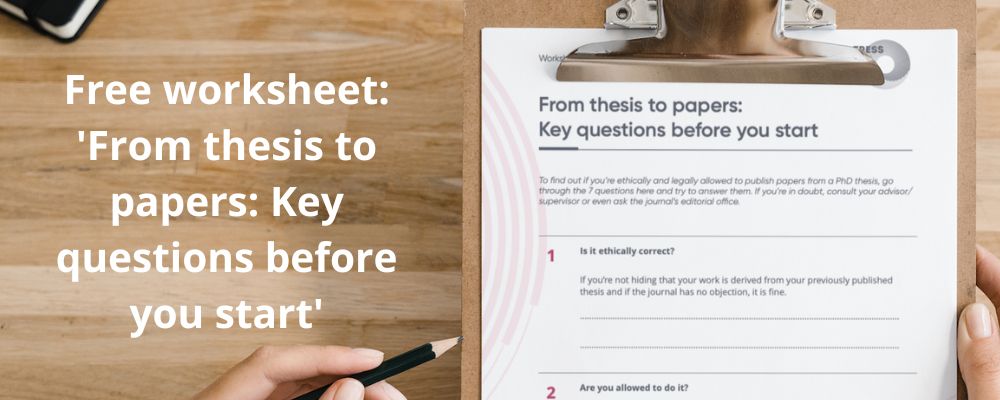If you have completed your PhD with a monograph, AKA a thesis, you might wonder if you can convert your thesis into journal papers. Are you allowed to do this, and what is the best way to do it? Here, we describe the steps you should consider when you convert your PhD thesis into papers.
Converting a monograph PhD thesis into papers is a great idea, particularly if you want a career in academia. Papers are the current currency in academic career development. You want to show others that you’ve done good work. And if you have not written papers alongside the monograph, it seems obvious to consider writing papers based on your PhD project after the monograph is completed. Journal papers will help spread the results of your PhD study in your community; papers have a better reach and are easier to consume by your peers than a monograph thesis. So there are very good reasons to publish papers from a PhD thesis!
Of course you could have written papers from the start, but if your PhD ended with a monograph, it is pointless starting such a discussion now. There are often many practical reasons why you published a monograph and not papers. For more details on this discussion, see our post #6, Dissertation dilemma? Hand in a monograph or papers?
What counts now is that you’re considering getting more out of your thesis by turning some of your thesis work into papers. We want to help you with these 10 steps that you can follow:
1. Answer these essential questions first
Successfully completed PhD researchers often ask the question: “Can I publish papers from my monograph?” In general, we say: “Yes, you can, but … you first must determine whether you’re allowed to publish your work with regard to permissions, copyright, ethics, originality, plagiarism, and foreign language versions.” If you’re unsure on these issues, please have a critical look at the 7 questions that we’ve prepared for you in the free worksheet “Key questions before you start.” Once you’ve checked this and you know you’re allowed to publish your work, follow the remaining steps outlined below.

2. Select content from your thesis
The structure and extent of detail vary between PhD monographs and journal papers. Don’t aim to include all of your thesis in one paper—this will likely result in a too long, too broad, and less interesting paper. Readers of journal papers often look for answers and input on specific problems, and your thesis encompasses too many problems and topics. Select one of the topics from your thesis for one paper, and another one for another paper, if you like. Of course, you can write several papers from your thesis, and also several paper types. Have a look at post #28 about What type of journal paper to write?
3. Don’t copy and paste but rewrite and update
You might feel tempted to copy whole sections, if not chapters, from your thesis and paste them into your paper.Don’t do it! A journal paper is less wordy and has a different internal logic than a monograph chapter. It is much better to rewrite what you wrote in the monograph and update it with new references or information where necessary and possible. Doing so will strengthen the originality of this new paper compared to your monograph!
4. What is original in your work?
Space in the journal paper is very limited, and so you should try to fill it with your most original work. In a monograph, you typically give the reader the big picture of a problem, including its historical development. Cut this down in your paper and focus on your work. You can assume that the readers of your paper are from your field, and they will know a lot about the background already. They are more interested in the new stuff that you’re contributing to the field.
5. Start with the most important work
You may plan to write at least 3, 4, or even 5 papers from your PhD work. If you can do this, you should definitely go for it, but sometimes life moves on and there isn’t enough time to follow through on all the plans we have. Most likely, you will only manage to write 1 or 2 papers from your monograph because you are working on a new project or a new position and there’s a lot of work to do there. To prevent running out of time to write up the really cool stuff from your PhD study, start writing the first paper on this stuff first. Pick your most important work from your PhD study and make sure it gets published. If something else comes up afterwards, you at least got this important work out there!

6. Transfer your introduction into a review paper
An obvious paper to write from your PhD monograph is a review paper. You have most likely done a detailed literature study on your PhD topic in a separate chapter of your thesis. This would be a great starting point for a literature review on the topic as you’ve done most of the work already. You would need to focus on a specific aspect for your review, report how you selected the literature in the first place, and look for recent updates to the literature since you did the review for your thesis. Then, identify a journal that could be interested in a review on this topic and go for it. Check our two posts #50, Mastering the literature review during the Corona lockdown, and #91, Find the right journal for your paper following these 8 steps for further help.
7. Tell the journal
In your cover letter, tell the journal editors that your submitted paper is based on your (un-)published PhD thesis and include the reference to it. Be very clear and open about it and don’t try to hide it, but also make it clear to the journal that you consider your paper a valuable and original contribution to the wider readership of the journal. Journals are not against publishing work from PhD theses in general as they would not consider a thesis a formal publication.
8. Cite your thesis
It’s not enough to tell the editors that your work is derived from your PhD monograph–make this clear to your readers and actively cite your PhD monograph. No need to cite it all the time in the paper–either pick a prominent place within your paper to cite it or add it to the acknowledgment section.
9. Limit the number of references
A PhD monograph is often a reference work where interested readers can find all the important literature that has been published on the topic so far. That’s not needed in a journal paper. Here, you’ll write for readers who are experts in the field, just like you. Of course you should refer to the most recent relevant studies and give credit to all the work you used, but don’t provide any additional references.

10. Keep your text short
How many pages is your monograph? About 100, 200, or more? However long, it is far longer than the paper you’re going to write and this can make it difficult to pare down. You’ll probably think that your paper is too short and then you’ll add one more paragraph and another because there’s plenty of material to take from the monograph. Don’t be afraid when your paper looks skinny next to your monograph–if all relevant, and not all available information is included, it’s the right length!
Conclusion
For any academic career you might pursue, having a selection of papers that detail your work is indispensable! Therefore, seriously consider turning some of the material from your PhD monograph into journal papers—only the material you’re most proud of. You’ll need to check first that you’re not running into any ethical or legal conflict by doing so, and you’ll also need to consider the specific rules within your academic field. A great source for help is the website of the Imperial College London (2022), and our worksheet Key questions before you start will help you double-check, but for most cases, it won’t be a problem to turn your thesis into papers. In fact we think it is a great idea, and encourage you to do so!

Resources:
- Free worksheet: Key questions before you start
- Smart Academics Blog #6: Dissertation dilemma? Hand in a monograph or papers?
- Smart Academics Blog #28: What type of journal paper to write?
- Smart Academics Blog #50: Mastering the literature review during the Corona lockdown
- Smart Academics Blog #91: Find the right journal for your paper following these 8 steps
- Imperial College London, 2022. Publishing material from your thesis. Accessed 9 May 2022.
More information:
Do you want to successfully write and publish a journal paper? If so, please sign up to receive our free guides.
Photo by Aaron Burdon on Unsplash
© 2022 Tress Academic
